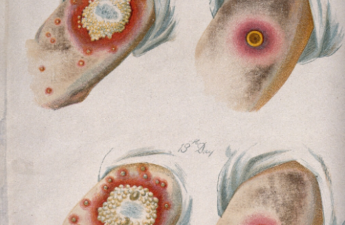
by Steve Halbrook
A favorite tactic of pro-vaccine propagandists is to dismiss the countless deaths and injuries obviously caused by vaccines by saying “correlation is not causation.”
Of course, this is only used when it suits their purpose. When it comes to disease eradication by vaccines, correlation is most definitely considered by them to be causation; that is, when a vaccine for a particular disease precedes the decline of the disease, then surely, we are told, the vaccine must be responsible.
That is, if we conveniently ignore legitimate reasons for the disappearance of diseases, such as hygiene and sanitation. As Dr. Thurman Rice once said,
It is not strange that health improves when the population gives up using diluted sewage as the principle beverage [1932]).
Indeed, the CDC itself states this about improved sanitation’s effect on polio:
In the immediate prevaccine era, improved sanitation allowed less frequent exposure and increased the age of primary infection.[1]
Let us also not forget the benefit that quarantine can play in fighting diseases.
It is not just quarantine and improved hygiene and sanitation that can result in the decline of disease; diseases can decline for other reasons — and may even disappear suddenly with no explanation.
As reported in the Report of the Medical Officer of Health by the City of Glasgow (1958),
The causes of decline of an epidemic are difficult to define. Weather conditions are an obvious factor. It is also reasonable to think that the building up of herd immunity in the population plays a part. This increasing immunity has in past epidemics been due to natural infection. In 1958 natural and artificial immunisation worked in parallel. It is suggested, with some diffidence, that the critical level of herd immunity was reached more quickly as a result of vaccination.[2]
In referring to “artificial immunisation,” the report holds that the polio vaccine played a role in reducing polio, an idea that we have challenged elsewhere. However, it does acknowledge that diseases can decline for other reasons (e.g., weather conditions). It even notes that “herd immunity” can be achieved via natural infection, and acknowledges its role in reducing polio even after the polio vaccine was introduced.
The London Medical and Surgical Journal (1832) makes this observation about epidemics:
As yet the cholera has not caused a great mortality, and if we reflect upon the mysterious course of epidemic diseases in all ages and countries, it appears to us, notwithstanding the great predisposition or liability of the Irish to the cholera, it may, like thousands of other epidemics, suddenly disappear; or effect much less mortality than on slight consideration might be expected. In our last Number there was ample proof of this statement afforded in the article on the epidemic diseases of Ireland, by which it appeared, that the devastating pestilence of 1348, which was so fatal in every part of Europe, and especially in England, was comparatively limited in its effects on the inhabitants of Ireland. In the present instance, time alone must determine the correctness or incorrectness of our assertion.[3]
While discussing cholera, the following is said in the British Medical Journal (1865):
Probably, as measles, scarlet fever, small-pox, etc., mysteriously flash out, and still more mysteriously disappear, so would it have been here. To induce those mighty epidemics that desolate a world, there must be something more—some great pervading influence, that science only knows from its effects.[4]
In an 1877 report from the U.S. Department of the Interior, we read:
Thus, even a calamity, under certain circumstances, can be rendered advantageous to a certain point, as, for instance, it is a well established fact that after heavy storms malignant epidemics suddenly disappear.[5]
More recent statements are found in Ebola Virus Disease: From Origin to Outbreak by Dr. Adnan I. Qureshi:
The third pattern is the “tooth eruption” pattern where, like the tooth hidden within the gums and emerging indepedent of other teeth, the pathogen emerges and is exterminated without any relation to previous occurences. The Ebola virus is one of the pathogens following the “tooth eruption” pattern where the disease emerged in Sudan and the Democratic Republic of Congo (DRC) in 1976, disappeared, and then reemerged in Uganda between September 2000 and February 2001, only to mysteriously disapear. It emerged again in December 2013 in Guinea.
What is far more perplexing is why epidemics die their deaths, a phenomenon noticed since the beginning of humanity. While it is convenient to believe that measures such as vaccination of at-risk individuals, quarantine of diseased persons, and acute and timely treatment are the cause of epidemic eradication, the facts do not support such a conclusion. In fact, the largest epidemics, such as the Peloponnesian War Pestilence, Antonine Plague, Plague of Justinian, Black Death of the fourteenth century, and Spanish flu, came to an end without widespread use of any of those strategies.[6]
Regarding polio itself: after the national polio vaccine program was implemented, Oak Part, IL, Health Commissioner Herbert Ratner, M.D., in 1956 writes in the Journal of the American Medical Association that poliomyelitis was not only uncommon, but that many factors unrelated to vaccination have been keeping it at bay:
The Idaho data simply confirms the fact that poliomyelitis is a low-incidence disease and that there is a high degree of acquired immunity and many natural factors preventing the occurrence of the disease (as contrasted to an “infection”) in the Nation at large. … Everyone should recognize that 1955 was a low poliomyelitis year independently of the use of the Salk vaccine, which was only given to 9 million children.[7]
Of course, a disease may appear to be going away right after the launch of a vaccine because of the misuse of data, making the vaccine appear effective. For instance, the polio vaccine was made to look effective after the disease was conveniently redefined. Disease eradication is easy when you cheat.
And so, as we can see, there are various possible reasons why a particular disease may be in the decline. It is oversimplifying things to give vaccines the credit, which are deadly and can even contribute to the spread of disease.
When it comes to vaccines ending disease, then, correlation most definitely does not prove causation. Correlation and causation regarding the role of vaccines in causing endless death and suffering, however, is another story …
Notes
_____________________________________________________
[1] Centers for Disease Control and Prevention, Epidemiology and Prevention of Vaccine-Preventable Diseases: The Pink Book Home, Poliomyelitis. Retrieved January 31, 2017, from https://www.cdc.gov/vaccines/pubs/pinkbook/polio.html.
[2] City of Glasgow, Report of the Medical Officer of Health (The Corporation of the City of Glasgow, 1958), 131. Retrieved March 15, 2017, from https://archive.org/stream/b28652459#page/130/mode/2up.
[3] Michael Ryan, ed., “Cholera in London, Dublin, and Paris” (May 5, 1832, vol. 1, no. 14), The London Medical and Surgical Journal; Exhibiting a View of the Improvements and Discoveries in the Various Brances of Medical Science, vol. I (London: Renshaw and Rush, 1832), 441.
[4] D.B. White, Northern Branch: President’s Address, Transactions of Branches (December 2, 1865), in William O. Markham, ed., The British Medical Journal, Being the Journal of the British Medical Association, vol. II for 1865, July to December (London: Thomas John Honeyman), 576.
[5] Department of the Interior, United States Geological Survey, F.V. Hayden, U.S. Geologist-in-Charge, First Annual Report of the United States Entomological Commission for the Year 1877 Relating to the Rocky Mountain Locust and the Best Methods of Preventing its Injuries and of Guarding Against its Invasions, in Pursuance of an Appropriation Made by Congress for this Purpose, with Maps and Illustrations (Washington: Government Printing Office, 1878), Appendix III: Texas Data for 1877, 72.
[6] Adnan I. Qureshi, Ebola Virus Disease: From Origin to Outbreak (San Diego, CA: Elsevier, 2016), 40.
[7] Herbert Ratner, “Poliomyelitis Vaccine,” Journal of the American Medical Association (Jan. 21, 1956). Cited in Intensive Immunization Programs, May 15th and 16th, 1962. Hearings before the Committee on Interstate and Foreign Commerce House of Representatives, 87th congress, second session on H.R. 10541, 89. Retrieved February 15, 2017, from http://www.whale.to/v/greenberg1.pdf.
If you find this site helpful, please consider supporting our work.

